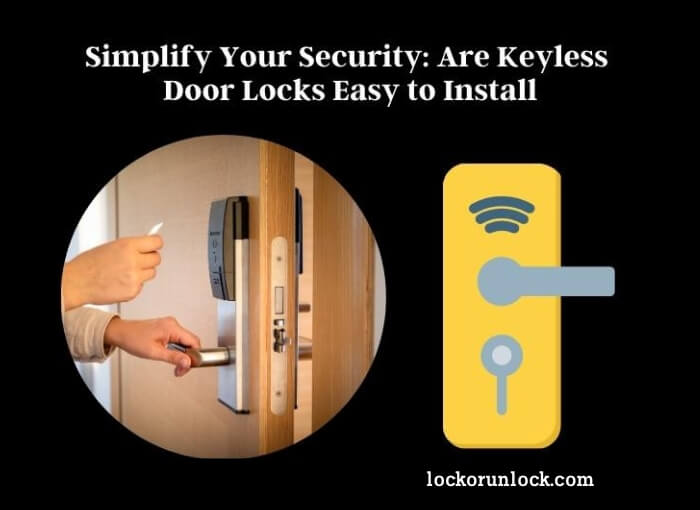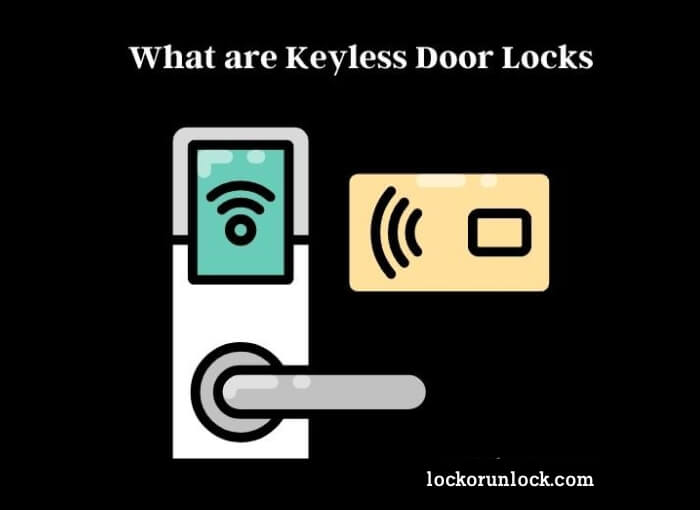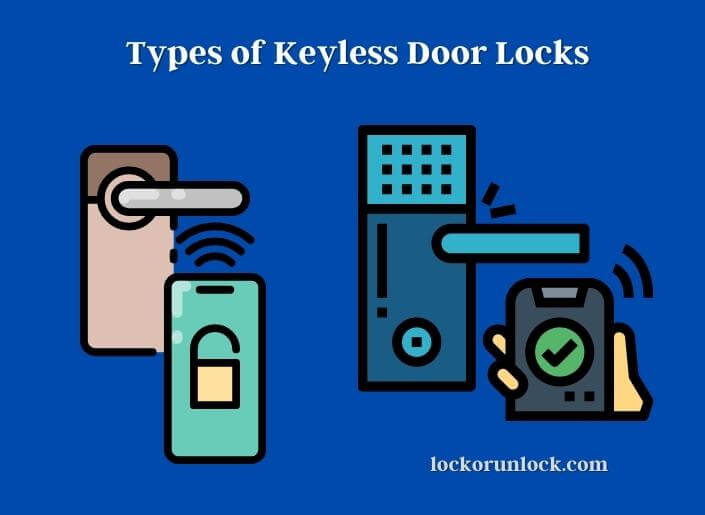Keyless door locks are becoming increasingly popular due to their convenience and security. Unlike traditional locks, which require a physical key, keyless locks use a combination of codes, fingerprints, or other forms of identification to unlock. Installing a keyless door lock may seem daunting, but it is simple.

Most people can install a keyless door lock quickly with some basic tools and a few steps. This guide will outline the installation process and provide tips on ensuring your keyless door lock is installed correctly and securely.
Are Keyless Door Locks Easy to Install From Other Door Locks?
When compared to other door locks, keyless ones are generally easier to install. Traditional locks typically require more tools and hardware to install and more complex processes such as drilling and cutting. Keyless door locks, on the other hand, usually come with all the necessary hardware and tools required for installation, and the process can generally be completed in under an hour.
Keyless door locks often have simpler mechanisms and fewer moving parts than traditional locks, making them easier to install and maintain. They also don’t require using keys, eliminating the need for conventional key duplication and lock picking.
The installation process can vary depending on the specific type of lock and the door it’s being installed on. Keyless door locks are generally easier to install than traditional ones.
What are Keyless Door Locks?
Keyless door locks are a modern locking system that allows you to enter your home without using a traditional key. These locks use a code, card, or fingerprint recognition to unlock the door, providing a secure and convenient way to enter your home. Keyless door locks are becoming increasingly popular and for a good reason. They offer a range of benefits that traditional locks cannot match.

What are the Benefits of Keyless Door Locks?
Keyless door locks have become increasingly popular in recent years due to their convenience, security, and ease of use. Here are some of the top benefits of keyless door locks:
1. Increased Security:
Keyless door locks provide increased security because they are more difficult to pick than traditional locks. Most keyless locks use a combination of numbers, letters, and symbols in order to unlock them, making them much harder to guess or break into.
2. Convenience:
Keyless door locks are convenient because you don’t need to carry a key with you. You just need to remember the combination in order to access your home or office.
3. Time-Saving:
Keyless door locks save time because you don’t have to fumble around in your pocket or purse to find your keys. You can just enter the combination quickly and easily.
4. Flexibility:
Keyless door locks provide flexibility because you can create different combinations for different people. You can also easily change the code when needed.
5. Cost-Efficiency:
Keyless door locks are usually more cost-efficient than traditional locks because they require less maintenance and are more durable.
Types of Keyless Door Locks
Before we dive into the installation process, the different types of keyless door lock available on the market. Here are the most common types of keyless door locks:

Keypad Locks:
Keypad locks require a code to unlock the door. They are easy to use and can be programmed with multiple codes for different users.
Smart Locks:
Smart locks can be controlled using a smartphone app or a virtual assistant like Alexa or Google Assistant. They are convenient and allow you to monitor who enters and leaves your home.
Biometric Locks:
Biometric locks use fingerprints or facial recognition technology to unlock the door. They are the most secure type of keyless door lock, but they can be more expensive than other types of locks.
How to Install a Keyless Door Lock?
Now that you understand the different types of keyless door locks let’s dive into the installation process. We will provide step-by-step instructions for installing a keypad lock, the most common type of keyless door lock.
Step 1 – Remove the Old Lock
The first step in installing a keyless door lock is removing the old one. To do this, use a screwdriver to remove the screws that hold the old safety in place. Once the screws are removed, the lock should easily come off the door.
Step 2 – Install the Keypad Lock
Once the old lock is removed, installing the keypad lock is time. The keypad lock will come with a mounting plate that you must attach to the door. Use the screws provided to attach the mounting plate to the door.
Step 3 – Install the Latch:
Once the mounting plate is in place, installing the latch is time. The latch will also come with a mounting plate. Attach the mounting plate to the door using the screws provided. Once the mounting plate is in place, attach the latch to the mounting plate.
Step 4 – Connect the Wires:
The keypad lock will come with wires to connect to the latch. Follow the manufacturer’s instructions to connect the wires. This will typically involve connecting the wires from the keypad lock to the wires on the latch.
Step 5 – Test the Lock:
Once the wires are connected, it’s time to test the lock. Enter a code into the keypad to ensure the lock works correctly. If the lock is not working correctly, double-check that the wires are connected correctly.
Basic Tools for Installation of a Keyless Door
When installing a keyless door lock, having the right tools can make the process smoother. Here are some basic tools you may need:
| Screwdriver | You’ll likely need a Phillips head screwdriver to install your keyless door lock. |
| Tape Measure | Accurate measurements are key to a successful installation. Use a tape measure to ensure proper alignment. |
| Drill | Some keyless door locks require holes to be drilled into the door or frame. Ensure you have a drill appropriate for the material you’ll dig into. |
| Hole Saw | If you need to drill larger holes for your lock, a hole saw attachment for your drill might be necessary. |
| Level | A level will help ensure your lock is installed straight and even. |
| Pliers | You may need pliers to help remove the old lock or tighten screws during installation. |
| Safety Glasses | When using power tools or drilling into a door, it’s vital to protect your eyes with safety glasses. |
With these basic tools, you’ll be well-equipped to install a keyless door lock quickly and confidently.
Factors That May Affect the Ease of Installation
Installing a keyless door lock can be a straightforward process, but some factors could impact the ease of installation. Here are some factors to consider:
Type of Door
The kind of door you have can impact the ease of installation. For example, if you have a metal door, you may need different tools or equipment than a wooden one. Similarly, if your door is thick or thin, this can also affect the installation process.
Type of Lock
Keyless door locks have different installation requirements, and some may be more complicated than others. For example, some locks may require more wiring or programming, and others may be more straightforward. Research the lock you want to install to ensure you have the necessary skills and tools.
Previous Installation Experience
If you have experience installing locks or similar types of hardware, you may find the installation process more manageable. If you’ve never installed a lock, you may need more time to familiarize yourself with the process.
Additional Features
Some keyless door locks come with other features, such as Bluetooth connectivity or a touchscreen display. These features can enhance the lock’s functionality, but they may also add complexity to the installation process.
User Error
Not a factor directly related to the installation process, it’s worth noting that mistakes or oversights during installation can impact the ease of installation. Be sure to carefully read and follow the installation instructions closely to avoid any errors or complications.
Installing a keyless door lock can be relatively simple. Consider these factors to ensure a smooth and successful installation process. If you need clarification on any aspect of the installation, it’s always best to seek the advice of a professional.
Can Keyless Door Locks Prevent the Issue of Locking Keys Inside a Mercedes?
Keyless door locks can definitely prevent the issue of locking keys inside a Mercedes. With the advanced mercedes locking mechanism, you can avoid the hassle of being locked out of your car. This technology allows you to enter and start your vehicle without having to physically use a key.
Does the Light Indicator on Keyless Door Locks Also Indicate Security Levels?
Yes, navigating through lock lights on keyless door locks can indicate security levels. Different colors or patterns of the light indicator may signify different security states, such as locked, unlocked, or potential security threats. It’s important to understand the specific meanings of the lock lights to ensure the safety of your home.
Are Cam Locks as Easy to Install as Keyless Door Locks?
Yes, cam locks for property security are as easy to install as keyless door locks. They require simple drilling and mounting, making them a great option for securing cabinets, mailboxes, and drawers. With their straightforward installation process, cam locks offer convenience and reliable security for your property.
Can Keyless Door Locks Be Installed in Cars for Added Security?
Yes, keyless door locks can be installed in cars for added security, reducing the risk of car locking with keys inside. This modern technology allows for remote access and provides convenience while decreasing the likelihood of being locked out of the car.
Bottom Line
Keyless door locks are generally easy to install, especially if you are replacing an existing lock. Keyless door locks, including keypads, smart, and biometric locks, are available on the market. If you are considering installing a keyless door lock, we recommend choosing a type that fits your needs and preferences.
And remember, if you are still deciding whether to install a keyless door lock, it’s always a good idea to hire a professional to do the job for you.
If you want to know about the lock industry. Click here to know this.
Relevant Resources:
